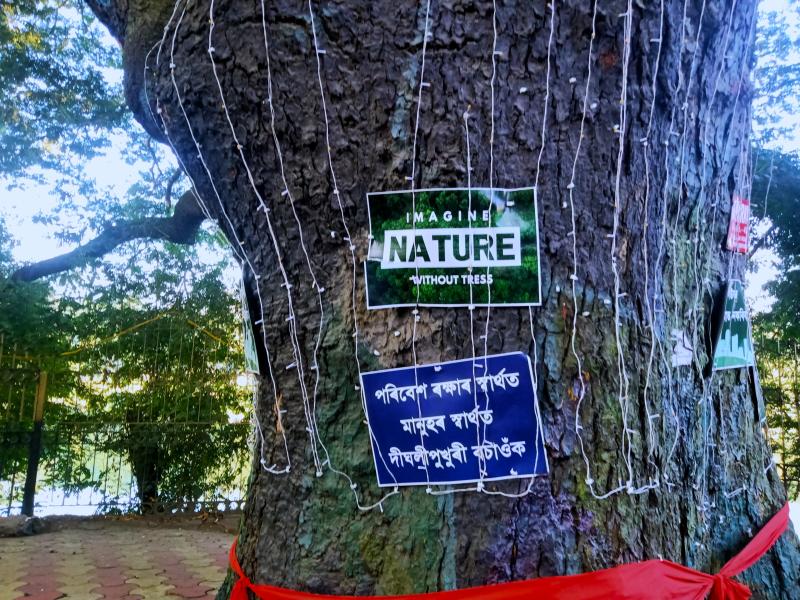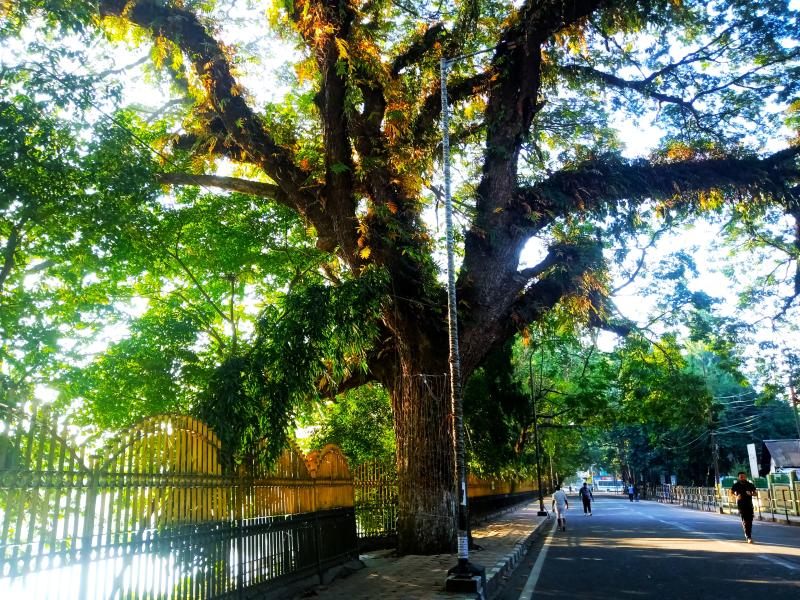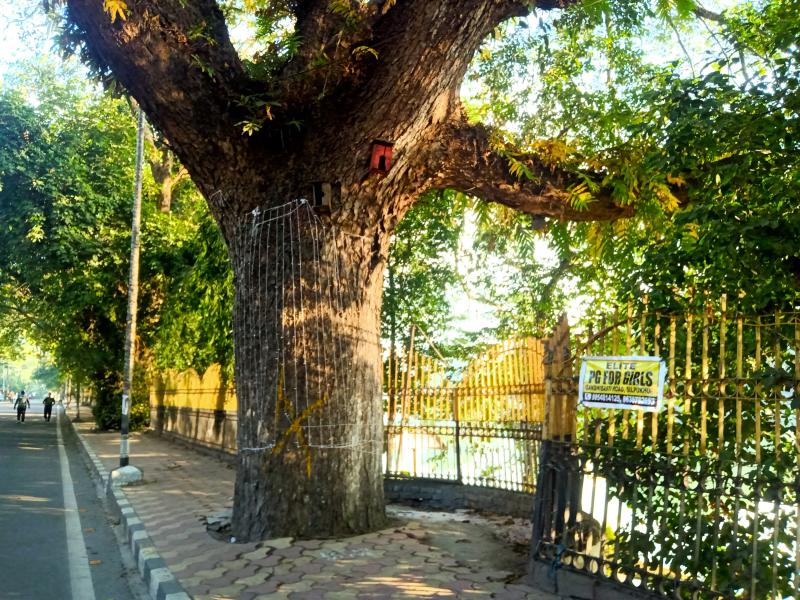Dighalipukhuri, a rectangular pond situated in the heart of Guwahati city, is steeped in history and tales. Some legends connect it with Bhagadatta from the Mahabharata, while historical accounts indicate that the pond served as a dock for the Ahom rulers. The pond has been a symbol of love since the British era, a legacy that endures to this day. Dighalipukhuri has been a subject of attention since 2016 when a war-memorial was created around it. However, very little is spoken about the ecological diversity in and around the pukhuri. With numerous tree species present around the pond, species of birds, mammals, insects etc. thrive on it, making it an ecological gem.
The avenue trees surrounding Dighalipukhuri serve as a vital sanctuary for birdlife in Guwahati, supporting a diverse array of species that rely on its green spaces and waterbody for survival. This area, characterised by its century-old trees and vibrant birdlife, is not only a testament to a healthy urban ecosystem but also a cultural and historical landmark, connecting generations of locals to the city’s heritage.

A recent survey done by students of the Environmental Biology and Wildlife Sciences Department, Cotton University, documented the presence of Cassia Tree (Senna siamea), Rain Tree (Samanea saman), False Ashoka Tree (Monoon longifolium), Peepal Tree (Ficus ligiosa), Yellow Flame Tree (Peltophorum pterocarpum) and Banayan Tree (Ficus bengalensis) around Digholipukhuri. Seventy-two (72) species of birds have been recorded here, including a significant number of nesting birds entirely dependent on these trees.
Here are several key aspects that underscore the significance of this unique site:
In 2022, over 52 Eastern Cattle Egrets were documented nesting in the avenue trees around Dighalipukhuri, along with 41 Little Cormorants 21 Intermediate (Medium) Egrets , 15 Great Egrets and 60 Black-crowned Night Herons. This congregation of heronries is particularly uncommon in an urban setting, highlighting Dighalipukhuri’s ecological richness and its role as a vital refuge for diverse bird species. Heronries are rare in Guwahati city, underscoring the area’s importance as a haven for nesting birds.
Among the most vulnerable residents of Dighalipukhuri are the hatchlings, nestlings, fledglings, and juvenile birds that depend on the trees for safety, food, and shelter. In their early stages, these young birds often wait alone in nests while their parents search for food. The towering trees offer essential refuge, protecting fledglings from predators and the urban hazards of the city.
Scaly-breasted Munias can be observed nesting in the False Ashoka trees (Monoon longifolium), while Lineated Barbets, Blue-throated Barbets, and House Crows actively gather nesting materials from various tree species present in the area. The fig trees in the area attract a variety of frugivorous birds, including Chestnut-tailed Starlings, Common Mynas, Jungle Mynas, Indian Pied Starlings, Great Mynas, and occasionally, Common Hill Mynas . Among these, the continuous chirping of Indian Pied Starlings stands out as a fairly common sight around the area for a passerby, with the species frequently nesting on these trees. Additionally, species of barbets such as the Lineated Barbet, Blue-throated Barbet, and Coppersmith Barbet depend on trees like Sacred Fig (Ficus religiosa), Bael (Aegle marmelos) for both feeding and nesting.

The inflorescence of trees like Siris (Albizia lebbeck) and Rain Tree (Samanea saman) also attract sunbirds and flowerpeckers adding vibrancy to the area. Two species of woodpeckers—the Fulvous-breasted Woodpecker and Black-rumped Flameback—have been documented in this location, further underscoring the plant-bird relationship.
Refuge for Migratory Birds Dighalipukhuri plays a crucial role in nature by providing wintering ground for various migratory bird species. Among the notable visitors are the Brown Shrike,Taiga Flycatcher, Yellow-browed Warbler, Greenish Warbler, White Wagtail, and Citrine Wagtail. This area is an important habitat for these birds during their seasonal migrations, offering a reliable stopover where they can rest and refuel.
The abundance of insects associated with the trees in Dighalipukhuri supports these migratory birds, providing a rich food source that sustains them during their stay. Habitat for Raptors and Other Predators Raptors such as the Shikra, Oriental Honey and Black Kite frequently visit Dighalipukhuri, indicating a balanced ecosystem capable of supporting various trophic levels. Nocturnal birds of prey, including the Spotted Owlet, Asian Barred Owlet, Collared Scops Owl, and Brown Hawk Owl have also been recorded in this area. The essential role these species play in controlling rodent populations is often underestimated, highlighting their importance in sustaining ecological balance. During March 2024, a migratory Peregrine Falcon was observed in the area. The presence of such raptors indicates the ecological health of the area, as these birds of prey rely on diverse prey populations to thrive.
Dighalipukhuri is much more than a historic pond situated in the heart of Guwahati; it is an elixir of ecological integrity, cultural heritage, and urban biodiversity. Any mega infrastructure project like flyover around Dighalipukhuri, would impact these century-old trees, which are not merely scenic elements but vital components of the local environment. These trees provide crucial habitat and nesting sites for numerous bird species, while their roots help stabilize the soil and regulate the local climate. Removing them would not only disrupt the bird populations that rely on this sanctuary but also diminish the overall biodiversity that has thrived here for generations.

In a modern world where cities increasingly recognize the need for green spaces and a renewed connection to nature, Dighalipukhuri stands as a rare symbol of harmony between history and natural heritage for Guwahati’s people. It’s time we view this as a “natural monument,” an ecological treasure that deserves preservation as part of our collective legacy, safeguarded with the same dedication we show to historic landmarks.
Any threat to its ecological integrity, particularly from urban infrastructure projects like a flyover, would not only disrupt a fragile ecosystem but also the cultural bond that has endured for many years. Such actions could lead to irreversible consequences, impacting not only the wildlife but also the community that cherishes this unique space. Protecting Dighalipukhuri is essential for maintaining the ecological and cultural identity of Guwahati, ensuring that future generations can continue to experience and appreciate this vital natural heritage.